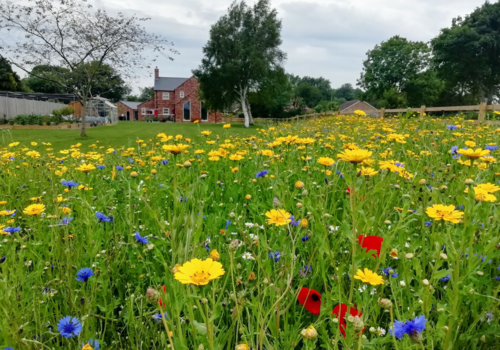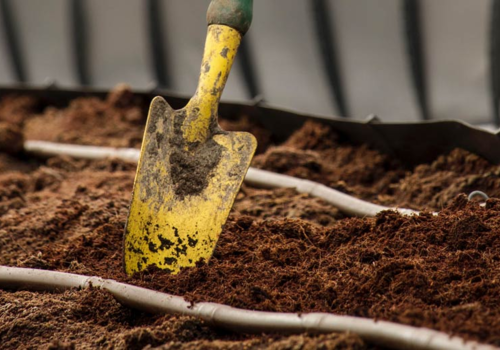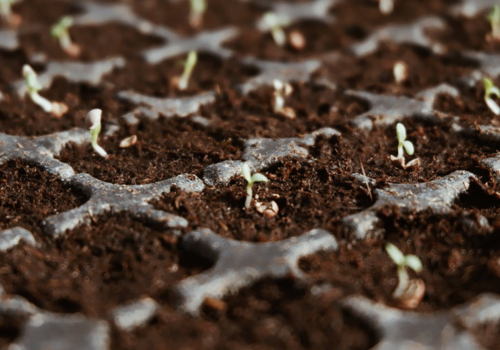Bees play a crucial role in pollination, supporting biodiversity and food production. Unfortunately, habitat loss and pesticide use have significantly reduced bee populations. One of the easiest and most beautiful ways to support these essential pollinators is by planting wildflowers.
Choose the Right Wildflowers
Selecting the right flowers is essential for attracting and supporting bees. Native wildflowers are the best choice because they have evolved alongside local bee species, making them an excellent food source. The best wildflowers for pollinators have flowers with high nectar and pollen content, such as:
Red Clover (Trifolium pratense) and White Clover (Trifolium repens) offer bees and other pollinators a wide landing base and are a rich source of pollen and nectar.
Yarrow (Achillea millefolium) has a wide platform of small white flowers that attract bees and pollinators, and they get covered in pollen while collecting nectar.
Dandelion (Taraxacum officinale) is a fabulous source of pollen for bees who get covered in pollen as they land on the large landing pad!
Aim for a mix of flowers that bloom at different times of the year to provide a consistent food supply for bees from spring to autumn.
Find the Perfect Location
Wildflowers thrive in areas with plenty of sunlight. Choose a spot that gets at least six hours of sunlight per day. If you have a garden bed, a meadow, or even a strip of land along a fence, that’s an ideal location for your wildflowers.
If you have limited space, consider planting wildflowers in containers or window boxes. Even a small patch of flowers can help attract and nourish bees.
Prepare the Soil
Healthy soil is key to a thriving wildflower garden. Follow these steps to prepare the ground:
Remove weeds and grass – clear the area to reduce competition for nutrients and sunlight.
Loosen the soil – use a rake or hoe to break up compacted soil, which will help seeds take root.
Avoid fertilisers and pesticides – wildflowers generally do not need fertilisers, and chemical pesticides can harm bees. Use organic compost if necessary.
Plant the Seeds
There are two main ways to plant wildflowers: scattering seeds directly or starting them indoors and transplanting later.
Direct Seeding - scatter the seeds evenly over the soil. Lightly press them into the soil using your hands or a flat board, ensuring good seed-to-soil contact. Do not bury the seeds too deeply—most wildflower seeds need sunlight to germinate.
Transplanting Seedlings - if starting seeds indoors, plant them in small pots about 6-8 weeks before the last frost. Once they have grown strong enough, transplant them into the ground, spacing them according to their specific needs.
Water Wisely
After planting, water the area gently but thoroughly. Keep the soil moist until the seeds germinate, which can take one to three weeks. Once the flowers establish roots, they will generally require less water. Native wildflowers are often drought-resistant, but during dry spells, occasional watering will help them thrive.
Maintaining Your Wildflower Garden
Wildflowers are relatively low-maintenance, but some care will ensure they flourish:
Weed regularly – remove invasive plants that compete with wildflowers for nutrients.
Deadhead flowers – removing spent blooms can encourage further blooming.
Leave stems in winter – bees and other pollinators may nest in flower stems, so consider leaving them until spring before cutting back.
Avoid Chemicals
To create a bee-friendly habitat, avoid using chemical pesticides, herbicides, and fungicides. If pest control is necessary, opt for organic methods like neem oil or companion planting.
Encourage Diversity
Bees thrive in diverse environments. Along with wildflowers, consider adding flowering shrubs, herbs, and trees to provide additional food sources. Creating a layered habitat with plants of varying heights will attract a greater variety of bee species.
Provide Shelter and Water
In addition to flowers, bees need safe nesting spots and fresh water:
Create a bee hotel – a bundle of hollow plant stems or drilled wooden blocks can serve as a nesting site for solitary bees.
Leave patches of bare soil – many native bees nest in the ground, so avoid mulching every part of the land.
Provide a shallow water source – A dish with small stones and fresh water gives bees a place to drink.
Wildflowers from Boston Seeds
Planting wildflowers for bees is a simple yet impactful way to support pollinators and enhance biodiversity. By choosing native flowers, preparing the soil, and maintaining a chemical-free environment, you can create a thriving habitat for bees while enjoying a stunning and lively landscape. Every wildflower patch, no matter how small, contributes to a healthier ecosystem for these essential creatures and at Boston Seeds we have lots of wildflower plants and wildflower seeds for pollinators. These include our Bees and Butterfly Wildflower Seed BSBP 100% that contains 24 species from the RHS Perfect for Pollinators list and has been formulated to create a long lasting meadow and wildlife habitat. The Butterfly & Bee Wildflower Seeds BSBM 80/20 is ideal for creating a grass and wildflower meadow for bees and other pollinators and has been formulated to be visually attractive while providing a rich and plentiful food source for bees.
So, grab some seeds, start planting, and watch your garden come to life with the buzz of happy bees! For any questions, email the team or give us a call on 01205 280 069 where our experts will be happy to help.


